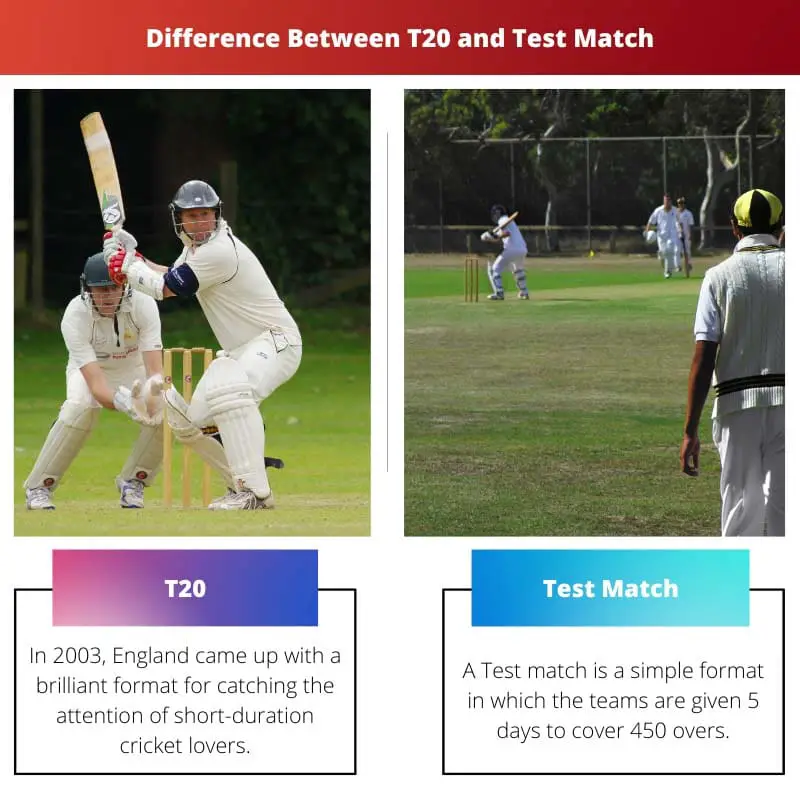The two popular cricket matches with different formats are known as test and T20 matches. A test match is a long-duration cricket match.
The test match requires the strength and patience of the players to play the match for hours together without long breaks.
The T20 match is a short-duration cricket match. The two teams play 2 innings in a T20 match which would be 20 overs for a single team.
T20 match is good for players that could not play for long durations.
Key Takeaways
- T20 is a shorter and faster format of cricket than test matches, with each team playing 20 overs, whereas test matches can last up to five days, with each team playing two innings.
- T20 is more focused on entertainment and is played faster than test matches, which require more strategy and endurance.
- T20 is more popular in countries like India and Australia, while test matches are considered the ultimate form of cricket and are played by all major cricketing nations.
T20 vs Test Match
T20 is a shorter game format, with each team playing for 20 overs. Test matches are in a longer format, with each team playing for up to 5 days. In T20, teams score more runs per over than in Test matches, as there is more emphasis on hitting boundaries and taking risks.

The T20 match format came into the role in 2003. The main intention behind the introducing T20 match was to gather more spectators on the field.
The viewers on the television would find the T20 match more interesting as the format would allow the players to play the game in a fast-paced way.
The test match was introduced in 1877 and the first match was played in Melbourne. The main intention behind introducing test matches was to increase the match time between two teams so that all the team members would get time to show their sportsmanship.
Comparison Table
| Parameters of Comparison | T20 | Test Match |
|---|---|---|
| Type | Short duration cricket match. | Long duration cricket match. |
| Overs or days covered | 40 overs for both teams. | 5 days or 450 overs. |
| Goals | Entertainment for a short period. | Entertainment for a long period. |
| Introduced in | 2003 | 1877 |
| Results | The possibility of a draw is not present. | The possibility of a draw is present. |
What is T20?
In 2003, England came up with a brilliant format for catching the attention of short-duration cricket lovers. In the T20 match, both of the teams are given 20 overs each for batting.
The main target both the teams in the T20 match is to win or lose. Each team mainly focuses either on making more scores or preventing the opposite team from scoring more.
The T20 players should not take more time for adding scores to the board as T20 is not a long-duration game. There is no chance that there would be a draw between two teams in T20 matches as the teams would either lose or win the game.
If both teams have scored a similar score, then power over may be granted to both teams.
The introduction of the T20 game has increased the popularity of cricket matches. The T20 match is the shortest match format in the history of cricket.
At professional levels, many countries are allowed to participate in the T20 matches. The rules and guidelines of the T20 match are almost equal to a one-day match which comes with 50 overs for each team.
The T20 match is more suitable for the fast cricketers that have less patience and more strength themselves. Some cricketers find it difficult to play for more than 2 to 3 hours.
These cricketers would find the T20 match a great format for scoring more in less time.

What is Test Match?
A Test match is a simple format in which the teams are given 5 days to cover 450 overs. The test match has four possible results depending on the scores of both teams.
The main focus of the players in the test match is to stand on the field for hours together without giving up.
The team should focus on saving their wickets to play the test match for a long time. For the spectators or viewers watching the same match for 5 days would be monotonous.
Therefore, the number of viewers for the test match would be less as compared to the T20 match. The players that have fast batting techniques may not be able to play the test match for a long time.
Test matches are mainly for slow or energetic players that can hold the patience for 1 to 3 days without losing their wickets.
The test match would require the huge strength of the players. It’s not possible to score many runs in a test match as the main motive would be to save the wickets.

Main Differences Between T20 and Test Match
- The T20 match has 40 overs for both teams. The test match has 450 over for both of the teams.
- T20 match is the shortest match in the history of cricket. Test match is the longest match in the cricket world.
- A T20 match would require the team to score more runs in very less time. Test matches would require players to save their wickets and maintain their scores to stay on the field for a long time.
- T20 match doesn’t have the concept of a match draw in any situation. Test match would allow match draw results.
- T20 match is the best option for experienced cricketers as the low-energetic players can also play the game. Test matches would require young cricketers as it requires more energetic players.

- http://dspace.bracu.ac.bd/xmlui/handle/10361/4372
- https://www.sciencedirect.com/science/article/pii/S1877050917327023
